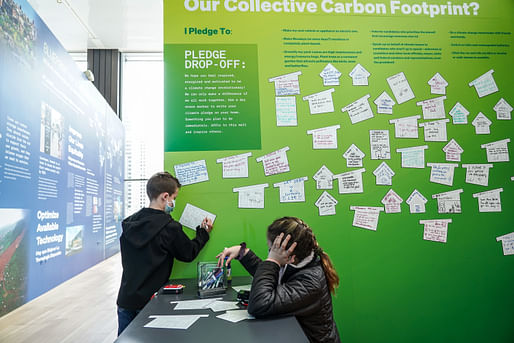
To coincide with the recent Earth Day celebrations, the Chicago Architecture Center has opened up its archives for a look inside the revolution that could restore the city, traditionally thought to be a mecca for the seminal works of 19th- and 20th-century architectural pioneers, to the top of the new mantle of sustainable design.
Titled Energy Revolution, the exhibition is being curated by Farr Associates founder and former Congress for New Urbanism Chair Doug Farr, an urbanist and outspoken sustainability advocate whose roots in the city extend nearly 40 years. Farr says one of his main goals was to “get architects to bring their clients to the show and start asking themselves the question: Can our next building be one that is all-electric and has no fossil-fuel connections?”
The answer is invariably tied to the direction shown by the city’s elected officials. On Friday, Chicago officially submitted a Climate Action Plan that includes a rather lofty 90% benchmark for adaptive reuse projects in its building stock by the year 2035. Other initiatives include the city’s recent divestment from fossil fuels, new carbon tax incentives, and a Berkeleyesque potential ban on natural gas, all of which Farr sees as the legislative extension of his curatorial “call to action,” which will in the end produce what he characterized as the city’s third design revolution after the heydays of Louis Sullivan and Mies van der Rohe.
By featuring a mixture of cutting-edge new materials he himself handpicked from last year’s PhiusCon, three full-scale wall mockups taken from the historic Monadnock Building and 860-880 Lakeshore Drive as well as pointed statistics, the exhibition critically displays the remarkable building performance disparities between midcentury designs typified by Mies and structures from 70 years before their construction, which use three times less energy on average according to today’s EUI metrics.

Farr’s own infrared-stitched photographs of buildings like the Hancock Center are among the various media included in support of the exhibition’s larger mission to trigger a sea change exemplified in new technologies and its curator’s plans for the new Academy for Global Citizenship, which was designed to the specifications of the Living Building Challenge. Farr also worked closely with Chicago’s Passive House Institute and Executive Director Katrin Klingenberg (“Their fingerprints are all over it,” says the curator) to highlight the unique ability of the method to impact design around the city through innovations displayed in an interactive “petting zoo” that includes high-performance wall assembly mockups and Cascadia windows.
Overall, Energy Revolution delivers an incisive look at the past and future role of architecture in creating and (potentially) defeating the incredible pessimism of our poisoned age.
“This is a way to get people into a space,” Farr said. “I called it a ‘spiritual space.’ You go there and are in the presence of prompts and signals and cultural representations that affirm your concerns about climate. I think a lot of people feel drifting, or despair, fear, angst, but in the exhibition, there’s real answers and a path forward.”

“We humans have self-inflicted a climate emergency,” he added finally. “The greater share of this crisis is traceable to our self-destructive production and waste of energy. The situational urgency compels us to stage an Energy Revolution, not one led by government but one led by us, the people.”
Energy Revolution is open to the public now and will remain on view at the CAC’s Skyscraper Gallery until the end of October. More information regarding events and programs surrounding the exhibition can be found here.
No Comments
Block this user
Are you sure you want to block this user and hide all related comments throughout the site?
Archinect
This is your first comment on Archinect. Your comment will be visible once approved.